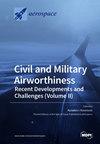Numerical Investigation of a Vortex Diverter Designed for Improving the Performance of the Submerged Inlet
IF 2.2
3区 工程技术
Q2 ENGINEERING, AEROSPACE
引用次数: 0
Abstract
The submerged inlet exhibits good stealth characteristics and lower drag, but it has a low total pressure recovery coefficient and high distortion rate, which limits its widespread application. This paper proposes a vortex diverter aimed at enhancing the performance of the submerged inlet and investigates the aerodynamic coupling mechanism between the vortex diverter and the submerged inlet in detail. Firstly, based on the flow field characteristics of the submerged inlet, the design principles of the vortex diverter are proposed. Then, the impact of the vortex diverter on the flow field of the submerged inlet is analyzed using the numerical method. Finally, the matching design between the vortex diverter and the submerged inlet is explored. The results show that the vortex diverter improves the average total pressure of the airflow inside the inlet by exhausting the low-energy flow from the larger radius side of the inlet, thereby suppressing flow separation and enhancing flow field uniformity. The vortex diverter improves the intake performance of the submerged inlet under different incoming flow Mach numbers, inlet exit Mach numbers, angles of attack, and small sideslip angles. The maximum increase in the total pressure recovery coefficient is 3.1099%, and the maximum reduction in the circumferential total pressure distortion is 49.5207%. Among the design parameters, the horizontal distance between the leading edge of the vortex diverter and the inlet lip has the greatest influence on the intake performance, and the best control effect is achieved when the vortex diverter is installed at the throat position. Furthermore, after installing the vortex diverter, reducing the side-edge angle of the entrance appropriately can effectively reduce the intensity of the secondary flow, thereby improving the total pressure recovery at the exit and reducing the distortion rate.为改善水下进水口性能而设计的涡流转向器的数值研究
沉没式进气口具有良好的隐身特性和较低的阻力,但其总压恢复系数低、变形率高,限制了其广泛应用。本文提出了一种旨在提高沉没式进气口性能的涡流分流器,并详细研究了涡流分流器与沉没式进气口之间的气动耦合机理。首先,根据沉没式进气口的流场特征,提出了涡流分流器的设计原则。然后,利用数值方法分析了分流器对沉没式进气口流场的影响。最后,探讨了涡流分流器与浸没式进气口的匹配设计。结果表明,涡流分流器通过从入口半径较大的一侧排出低能量气流,改善了入口内气流的平均总压,从而抑制了气流分离,提高了流场的均匀性。涡流分流器改善了沉没式进气口在不同入流马赫数、进气口出口马赫数、攻角和小侧滑角条件下的进气性能。总压恢复系数的最大增幅为 3.1099%,圆周总压畸变的最大减幅为 49.5207%。在设计参数中,涡流分流器前缘与进气唇之间的水平距离对进气性能的影响最大,当涡流分流器安装在喉部位置时,控制效果最好。此外,安装涡流分流器后,适当减小入口侧缘角可以有效降低二次流的强度,从而提高出口处的总压回收率,降低变形率。
本文章由计算机程序翻译,如有差异,请以英文原文为准。
求助全文
约1分钟内获得全文
求助全文
来源期刊

Aerospace
ENGINEERING, AEROSPACE-
CiteScore
3.40
自引率
23.10%
发文量
661
审稿时长
6 weeks
期刊介绍:
Aerospace is a multidisciplinary science inviting submissions on, but not limited to, the following subject areas: aerodynamics computational fluid dynamics fluid-structure interaction flight mechanics plasmas research instrumentation test facilities environment material science structural analysis thermophysics and heat transfer thermal-structure interaction aeroacoustics optics electromagnetism and radar propulsion power generation and conversion fuels and propellants combustion multidisciplinary design optimization software engineering data analysis signal and image processing artificial intelligence aerospace vehicles'' operation, control and maintenance risk and reliability human factors human-automation interaction airline operations and management air traffic management airport design meteorology space exploration multi-physics interaction.
 求助内容:
求助内容: 应助结果提醒方式:
应助结果提醒方式:


